The twin planet and the extinction of dinosaurs
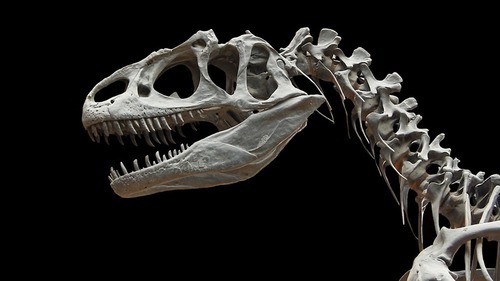
The mysterious extinction of dinosaurs is a very complex and confusing issue for the scientists, as they try to find a place for the dinosaurs in the evolution theory and to fit them in the Geologic time Scale of the earth. These attempts are going to keep them locked in the cage of Confusion and take them to a blocked road that ends with the same question mark.
With my new theory about the extinction of dinosaurs I try to solve the puzzling and confused theories about the extinction of a whole life form thought to have existed on earth.
The fact is that the dinosaurs didn’t exist on the earth we know, but probably even on another planet not far from our earth a kind of twin planet. The evidences that the dinosaurs lived on another planet:
1: The dinosaurs don’t really fit in the evolutionary chain or tree.
2: The impossibility to move on earth with their weight under the existing gravity.
3: It would be very difficult for a heart to pump the blood to the different body parts specially the brain in the large sized dinosaurs with the long necks.
4: It’s hard to imagine the amount of food consumed for the needed energy to move.
5: All the remains of that period are petrified in a different way than all other kinds of of fossils, Without finding any petrification of all other creatures that belong to other geological ages. .
6: The High concentration of CO2 in some rocks is a sign of a different planet. My theory depends on observation, logic and a lot of new researches made by scientists in the past 10 years using modern, cutting edge technologies examining dinosaurs and tree remains.
There is a lot of work done by scientists in recent time using modern technology, but it seems to be scattered efforts. I think there should be a database covering all that information and it be taken in consideration the geological surrounding of the discovery meaning the kind of stone and the relation between sandstone, limestone and granite. It should be registered what kind of stone was nearby.
Was there two different planets?
There are geological evidences of different formations of rocks not far from each other that don’t match logically in the time of formation. Like finding granite near sand or limestone in a way you can draw a line between them .You can see this on Sinai in Egypt, in South Africa, Australia or in the Grand Canyon Arizona. Some refer that to volcanic activity or a meteorite strike or plate tectonics. We have to think logically about the geological formation of earth. This formation took a long time, in the begging after the big bang the earth experienced dramatic changes like the whole solar system like the concentration of smaller parts in bigger planets.
The earth was bombarded by space debris which caused probably the fluid and hot core of the earth. That happened till the skies became clean of these debris and the planets ware formed. After that event the earth started to become stable and to cool down specially the external part. There is not a logical reason in the last 2 or 3 or 4 hundred million years that the earth went crazy causing large geological and topographical changing except some volcanic activities or earthquakes like today but not globally. There could happen a kind of global climate change like the ice ages put not global geological changes. What could happen is that the earth is attacked by some bodies from outside the system some are rocky and some could be ice, we could observe such bodies in the space. This could cause for sure global geological changes. But still there is another thing that can happen inside our solar system, that is that smaller planets start to gather to form bigger once. And that probably what happened with the earth, that there was a twin earth smaller than the other and not far from it. This planet was attracted or driven by the gravity of the bigger one which caused that the planet collided with the other and was absorbed by it or say it landed on it. Another possibility is that it was hit by a big meteorite which drove it to collide with the other. This comet or meteorite was probably formed mainly of granite; this explains the existence of the huge granite mountains and boulders all over the globe,in the Americas Asia or Egypt and the Arabian peninsula or even in England (Dartmoor National Park) and other places on earth.
I would think that the Granite planet which was traveling in space hit the planet near the earth which was formed mainly from Sandstone both broke into pieces or exploded and fall on the earth. That explains that the granite is scattered on earth and parts of the other planet too.
You find not only Granite Mountains but a lot of round granite blocks or boulders scattered all over the world which can only be formed in space and not on earth by plate tectonics.
These granite mountains fall Earth when there was a great ocean . It wasn’t a meteorite with a 100 km. in diameter put much bigger. There is another possibility that they have been a part of the other planet.
(The geological similarity between earth and mars may be an evidence that the granite doesn’t belong to Earth as it don’t exist on Mars )
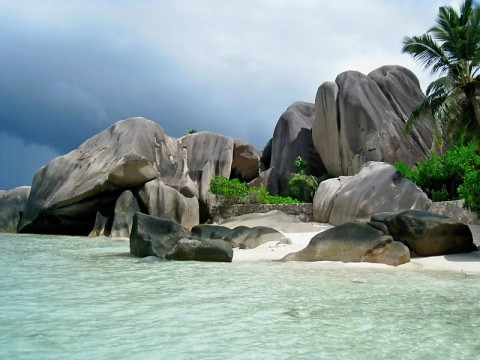
above the form of the granite rocks is round and have the form of many objects in the out space (the Seychelles).
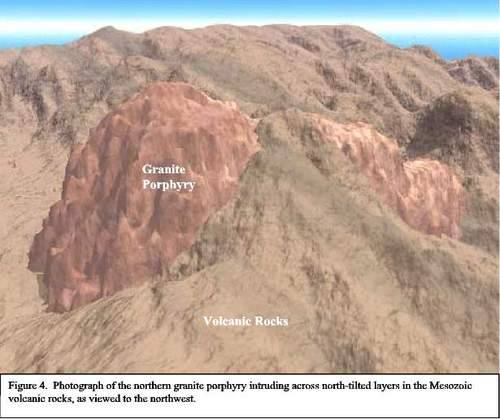
(above you see how the granite fall on the volcanic rocks and limestone at Sierra Cobre).
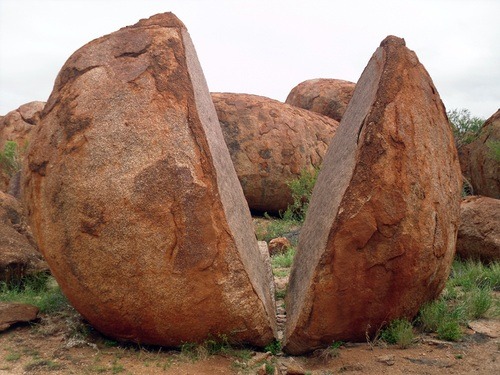
Above a granite rock broke in two parts after hitting the earth. ( devils marbles, Australia)

Above Punakitere Sandstone boulder in New Zealand also broken after hitting earth.
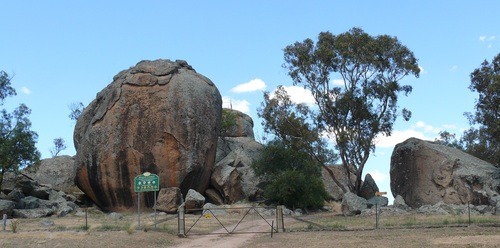
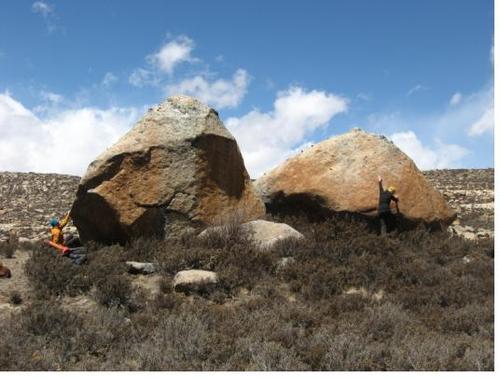
The hideout is a group of huge granite rocks in the middle of what is an otherwise flat plain at Walla Walla , Washington.
These boulders didn’t form by tectonic stress but they look more like the meteorites in space. The most believe that these boulders are glacial erratic which is a rock that differs from the size and type of rock native to the area in which it rests and are carried by glacial ice. I don’t agree with this hypothesis as these boulders can be found in many places like the African Sahara or Asia, places that didn’t experience any snow fall or ice age.Then we find these boulders on top of mountains and not just on lowlands which is illogic as it should move downwards and not upwards. Some of these boulders are so huge that they can’t be logically moved by ice. There are still a lot of glaciers around the world but we don’t see this Phenomenon happening in recent time.
One of the most famous examples for a large size glacial erratic is the Big Rock or known as Okotoks Erratic seen on the next image. It is located between the towns of Okotoks and Black Diamond, Alberta, Canada. It is a 15000 ton quartzite rock which can’t be considered as a boulder as it doesn’t have the typical rounded form which could be easily moved by ice. Particularly this rock is an excellent example that this rock hit the earth which caused it to crack in the middle. It is an evidence too that such formations are not related to plate tectonics which means that larger similar forms like plateaus that have the same shape and strata belong to the same formation.
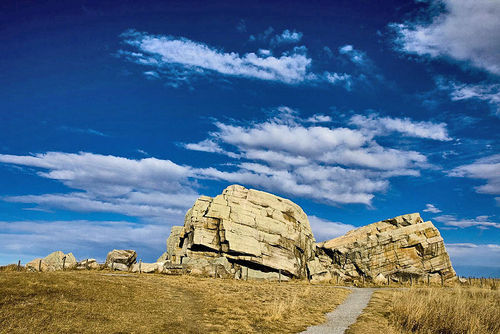
As you see that there are smaller parts of that rock just broke and fall beside, these smaller parts couldn’t have moved with the larger one by the glacial force.
The next image is the so called Clach Bharraig it is a large boulder perched on the hillside at the Cairngorm ski area in Scotland. Here you see a clear evidence of the impact, the boulder look like been shot at and a part just broke away.
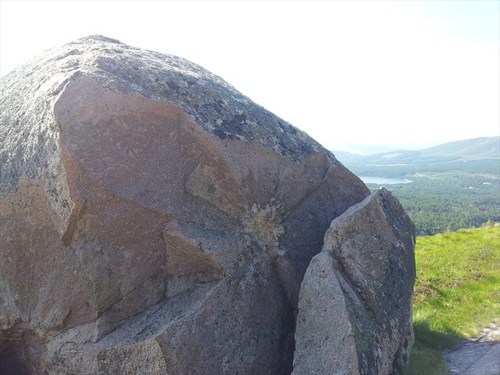
Another place in India is the Nagarjuna Hill which consists of huge granite boulders which cannot have been formed by glacial force as it’s a place which didn’t experience such events.
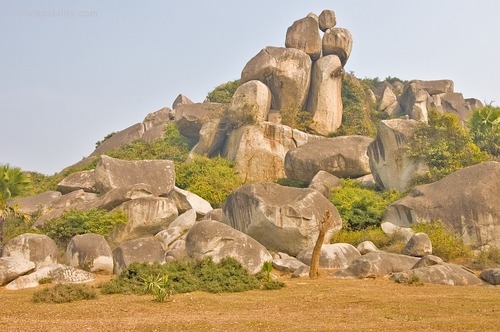
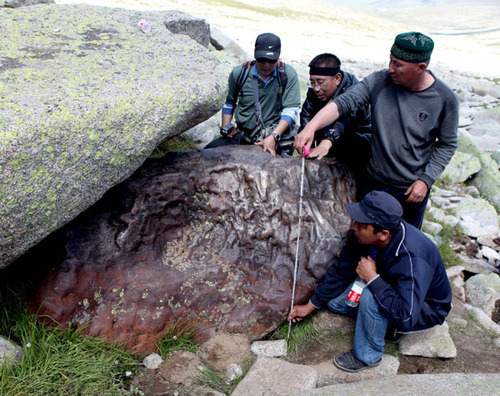
Above are Chinese astronomers inspect a big stony-iron meteorite that was found in Altay prefecture, Xinjiang Uygur autonomous region, on July 17, 2011. The above-earth part of the rock is 2.2 meters long and 1.25 meters tall. The location of the meteorite shows that it fall with the rest of the boulders as it didn’t cause any damage to the other boulders.
Read more: http://www.whatsonxiamen.com/news20233.html
This meteorite is found among other granite boulders or meteorites. Which is a rare case but is an evidence that these granite bodies when they were in space they pulled the iron meteorite while falling on earth.
I would say that after the planet explosion there was a kind of asteroid belt orbiting the earth similar to the asteroid belt located roughly between the orbits of the planets Mars and Jupiter.
Below is a satellite image of the Brandberg Granite Mountain in Namibia clearly seen the dark circle around the mountain caused by the heat of the impact. You notice too the two dark spots to the right were magma or lava came of it from inside the earth after the impact.
We notice that the body itself was cracked on two spots and the lava came out of the two spots.
By using modern seismic instruments such as seismographs it should be possible to prove that this mountain is a real mountain having mountain roots or not.
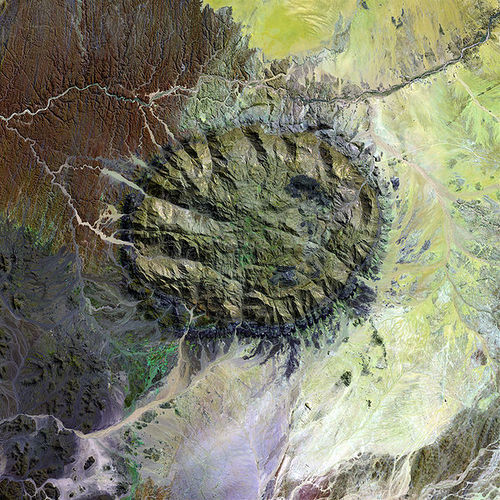
Another t evidence for the impact is the Verdefort crater in the Transvall Basin in South Africa, the largest impact crater on Earth almost 300 km in diameter. As shown below

It was originally thought to have been formed by a volcanic explosion, It consists of a granite dome 40 km in diameter in the center of the crater. Then we have different kinds of rocks forming rings round the crater center like an arc of Ventersdorp lavas formed by the lava flowing out of Earth after the impact and then we have the outer rings formed mainly by Ghaap Dolomite rocks a form of carbonate mineral like Limestone a part of the carbonate platform in the Transvaal and Griqualand West Basinswhich which belongs to the original Earth before the impact. We find high content of iridium in the area which is mostly found in meteorites . We find also platinum what I think that it has extraterrestrial origin and wasn’t formed on Earth, the same could be the case with gold and the whole platinum-group metals. Vredefort’s different magnetism is just simply because it belongs to a different planet.
Also the Tswaing crater in South Africa seen below is a smaller one (1.15 km diameter and 100 m deep) it has enough granite remains remains to be a prove that this meteorite was composed from granite. It’s also an evidence for the existence of stony meteorites impacts and not only iron meteorites.The surrounding area known as the Bushveld complex is one of the important sources of the platinum group metals. . The crate floor is covered with a high concentrated saline lake, what could be an indication that the salt on earth could have an extraterrestrial origin.
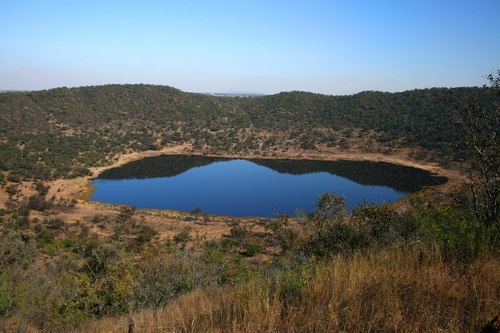
The Tenoumer crater in the western Sahara is another evidence for the abundance of granite in impact craters. The Atacama crater in northern Chile South America has a granite bedrock. The granite inside the crater that revealed a reverse magnetic field polarity, could be the belonging to a different plant with different polarity. The issue of reverse polarity is noticed mainly in the case of Granite and not Basalt. and creationists; it’s the power of physics that made everything possible and still showing us a lot of wonders happening in the universe.


Above you have the so called Bisti-badlands- in New Mexico a place not that known like grand canyon of great geological importance here you see clearly that the granite fall on the sand stone and how a part of the sand stone beneath was washed away. In grand canyon it’s usually said about the date gap questions that parts have been washed away. but washed away should look like above it wouldn’t completely vanished. Finding layers of nano diamonds in different parts of Earth is a sign of an impact but scientists don’t
find impact craters as an evidence for the impact. We find Granite Mountains not far from these areas, that’s because the granite is part of the impact. We don’t see even so much impact craters like on mars or Venus although the earth gravity is much bigger than both, that means that there should be more craters on Earth. The impact rocks changed the geology of Earth and buried the craters.
I think that the collision with the other planet or body is the reason that the earth geology and topography is so different from other terrestrial planets in our solar system.It may have caused the so called the Siberian traps and even the overheating of the earth core that caused the Siberian flood Basalt eruption. I even think that the Earth core cooled down like Mars and Venus and the collision reignited the Earth core and made it active till now.
I would even believe that the Alps which are mainly formed from Lime stone and they belong to the original Earth have been uplifted by the collision and not by plate tectonics a theory which I feel there is a lot to be debated.
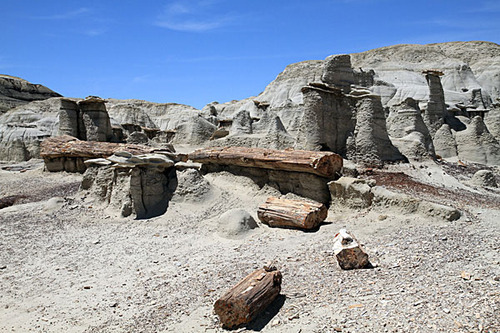
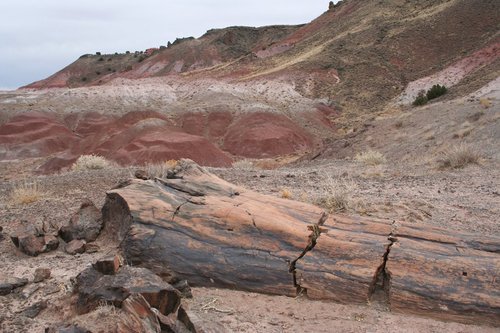
The landscape would give you the imagination of the two planets. there are also petrified threes laying on the surface of the ground.
Its interesting that where you find such landscape you find petrified trees and petrified dinosaurs.
See these images on Flicker and notice the remains of the two planets.
Some say that granite was formed by volcanic activity, but there is no evidence of such huge activity in that area and we couldn’t notice that lava have turned to granite after any volcanic activity in the present time. (In Iceland you can visit a volcano and go 1000 feet deep in to the volcano and you don’t notice any granite formations). It could be in the case of basalt and marble, as you can find layers inside the rocks but you don’t see that in the case of granite what is mostly formed of homogeneous block with no signs of layers.We still can observe the formation of Basalt in Iceland and Hawaii.
The big grains or crystals in granite can’t be formed by melting. We can see the formation of basalt in the bottom of oceans during volcanic activity, and the oceanic crust is composed primarily of basalt. The impact of the huge granite bodies could have caused the so called flood basalt and lava flows (Igneous Provinces) like the Siberian Traps happened at the time of the great extinction. They caused big holes in the earth crust and pressure that caused the earth interior to come out in huge masses in lava form. It is predicted that the granite or the so called igneous rocks are created by collisions of continental landmasses or volcanic activities under intense heat and pressure, but actually we still have lava coming out of earth but the content of lava is not the same like granite, we don’t see this happen in nature to prove it, even scientists Couldn’t prove that in lab. In lab is almost everything is possible nowadays, it happened with diamonds which are much harder than granite.
Granite must have been created by a different physics outside the earth, as the cosmos has a lot of illogical physics compared to what happens on earth, there are almost daily new discoveries in the universe that we can’t understand.
(Could granite be remains of planets that were sucked by a black hole ?)
(We didn’t ask our selves how the matter is going to look like after leaving the black hole )
What we don’t know today may be discovered tomorrow.
Like in the case of gold, it is assumed that gold has been transported
through the earth’s crust dissolved in warm to hot salty water. These fluids are generated in huge volumes deep in earth’s crust as water-bearing minerals dehydrate in metamorphism.
Another theory says that the full load of meteorite gold was thus added to the mantle.
New research suggests that all of the gold on Earth might have come
from cosmic crashes between super dense dead stars.
This theory seems more logic as gold is much complicated element than being formed on earth, otherwise it could have been created in lab. The same is the case of Diamonds, researchers have long wondered whether the high pressures inside the giant planets could turn carbon into diamond. http://www.nature.com/news/diamond-drizzle-forecast-for-saturn-and-jupiter-1.13925
The same is the case of granite, it has far more complicated structure to be created on earth. But as you see there are always new theories about the formation of matter than being thought before. Could granite be a result of a compression of a dead star that exploded after its death?
That means we shouldn't take old theories for granted, especially when they are not practically proven.
It’s not a combat between evolutionists and creationists; it’s the power of physics that made everything possible and still showing us a lot of wonders happening in the universe.
When you look to those mountains they look rather like the asteroids moving in the space, notice the sharp edges of the mountains, they look as if it have been broken apart into smaller pieces or parts some are scattered and they are round because of the effect of the earth atmosphere, which didn’t happen to the bigger once. You notice in some places that they rather fall from the sky and didn’t come from inside the earth. You notice the formation of the surrounding rocks which have been changed by being pushed from above rather than being pushed aside.
DINOSAUR TRAILS
Just 5 kilometers west of Sucre is the Cal Orcko cement quarry in Bolivia, famous for a wall inclined at an angle of 70 degrees which millions of years ago was a lake. What makes it special is that it is covered with hundreds of dinosaur tracks, from at least six different types of dinosaurs. The estimated age of the tracks is about 68 million years.As you can see in the image the possibility of being hit from the the top by a asteroid that caused the ground to rise in almost vertical position (The rocks seem to dip almost vertically down).

You notice that the place was wet and was petrified at the same time like the dinosaurs.They lived mostly in lakes to make them move easier because of their weight. (The petrified wet soil must have been petrified instantly otherwise the foot prints wouldn't last long,what happened to the bones happened to the soil).
You find such happening in other parts of the world, like at the Hartford Basin is one of the many rift basins along the east coast of North America, or at Jurassic Morrison Formation, near Red Rocks Park west of Denver.
You notice too that the impact have caused a great change in the earth surface, in the form of folding, cracks or parts of the surface stand upright what originally was vertical. It is clear that the uplifting after the formation of all rock stratas and no new layers have been added
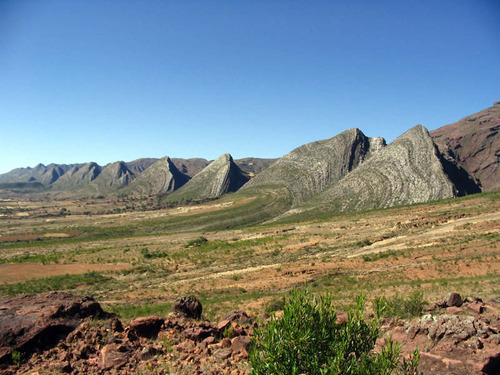
Above torotoro national park cochabamba in Bolivia nearby dinosaurs footprints have been found. Notice the position of the rocks.
With its wealth of fossilised bones, trees, plants and shells, Lesotho is known for having the largest concentration of dinosaur footprints in the world. It also has the distinction of having the world’s earliest known mammalian skeletal material which links the reptiles and the mammals. reed more:
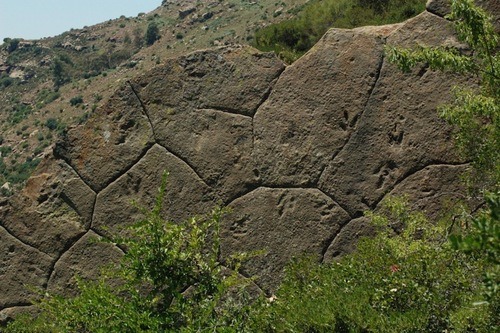
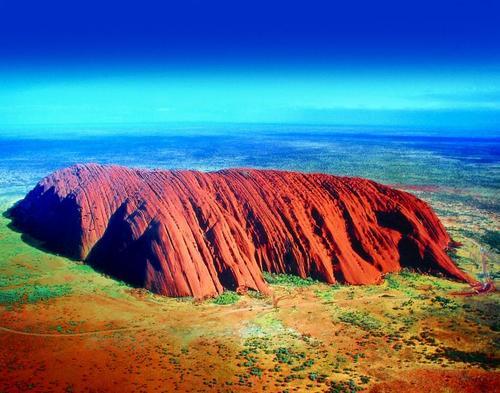
above the so called Ayers Rock or Red Rock in Australia, it’s probably a part of the destroyed planet that fall on earth. (clear are the horizontal layers that turned to vertical). Could Australia have been totally formed from parts of that twin planet, as limestone is rare in Australia?. Did that planet helped in forming other continents?. Is that the reason of the geological difference to New Zealand which is mainly formed of limestone and basalt and more volcanic activity? Did New Zealand belong to the original Earth which was formed mainly from Lime stone?.
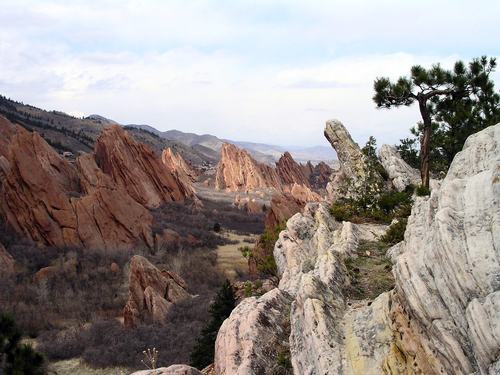
above you see clearly how a part of the sandstone planet hit the limestone on the other plant and pushed it high (Roxborough State Park - Colorado). You can see something similar at the Mammoth Flint Ridge in central Kentucky South of the Green River the insoluble sandstone and shale caprock over the
limestone, here you see a clear and sudden separation.
limestone, here you see a clear and sudden separation.
Below notice the relation between the granite and sandstone in grand canyon,very similar geology to Sinai in Egypt.
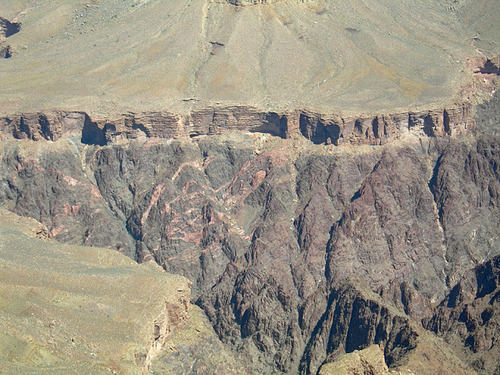
therefore I would believe that the sandstone and the limestone belong to different planets with different live forms. I am almost sure that they are not going to find lime stone or granite on mars. On earth you find places where sandstone mountains are not far from limestone almost the same height and level, that means that neither of them is older than the other because you don’t find them every were in layers above each in a kind of sequence. Sand is also common in the sea, why don’t we find the lime stone mixed with sand? We find mostly pure lime stone. We could find young mixed stones but not old ones.
I think that both stones have to do with the whole environment and geology of its own planet, that means that a planet can’t just change its formation just like that, either is it a sand stone planet or a lime stone planet. Otherwise we would find that the deeper part is one kind and the upper part the other kind of stone, as such a change would be global and not partly on earth. Most probably the fossil live found in the sandstone is not the same like in the sandstone.
The theory that the earth was hit by another planet already exist, it is predicted that scientists have found evidence of a previously unknown meteor bombardment after the Earth was formed 4.6 billion years ago, our planet was first hit by a meteor the size of Mars and then by a hailstorm of comets. This hypothesis states that the moon was formed out of debris left over from the collision of the two bodies; the colliding body is called Theia. Read:
Is there a possibility that this impact was at the time of the extinction and not 4.6 billion years ago?, but at least it opens the possibility that the earth was hit by another planet. I think it's almost impossible to have an accurate dating for such event.
Is there a possibility that the Permian extinction and the dinosaur extinction are the same but different planets?
Could dinosaurs live on our planet?
Now one of the planets was the home of the dinosaurs and other forms which don’t match in the in the evolution theory and have unexplained existence on earth. These forms couldn’t exist on earth specially the dinosaurs. There are different reasons for this believe: One of the biggest problems for the dinosaurs would be their weight. Many ancient dinosaurs were up to 150 feet in length like the Brachiosaurus. The biggest dinosaurs were the: (Here are some examples to imagine how huge)
1- The Argentinosaurus measured about 120 feet from head to tail and may have weighed over 100 tons.
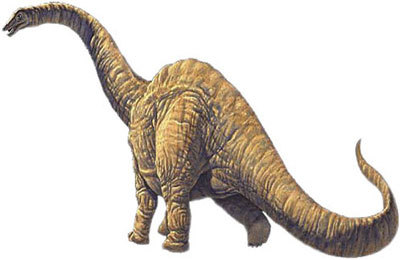
2- The Sauroposeidon about 50 or 60 tons. Its neck alone was almost 40 feet long!
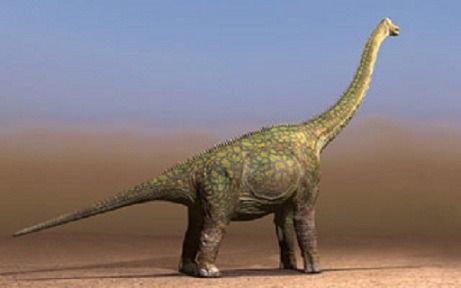
3- The pterosaur Quetzalcoatlus This gigantic pterosaur had a wingspan of up to 45 feet, making it the largest creature ever to fly.

4- The biggest hadrosaur: Shantungosaurus about 50 feet long and anywhere from 15 to 50 tons.

For such sizes it would be impossible to move and to fly, hippos spend most of their live in water to be able to move. Some dinosaurs are 50 times heavier. Scientists predict that these huge dinosaurs were good hunters , but how if they were so heavy, they had to be fast. Elephants and hippos as we see in our world are very slow because of their weight, they rarely run , hippos stay most of time in water so they can move easier. Hippos have been clocked at 30 km/h (19 mph) but only over short distances. This means moving fast on our planet would be impossible for dinosaurs. .

(Dinosaurs could have had strong mussels but still thin legs compared to their bodies and with their tail and long necks would be difficult to balance). Some of them have been capable of running on two legs, we notice that the legs are relatively thin to carry such a weight. According to the rules of gravity it would be almost impossible to move easily on earth with the present gravity.
There is a possibility that they lived in water which would have made their movement easier. Is the long neck to help them go deeper in the water and catching fish? Is the tail to help them swim like crocodiles? finding dinosaurs foot prints could be a sign that they lived in water or by the water?
It would be also very difficult in the case of large sized dinosaurs for a heart to supply such a huge body with blood specially the brain. It would be about 20m high - equal to a seven-storey building, standing with its neck up. ( the largest dinosaur found is thought to weigh in at 70 tonnes ).
Here you may find interesting information related to this subject:
Were the dinosaurs fish eaters? Some of them had similar teeth like deep sea fish, like the viperfish below or others.
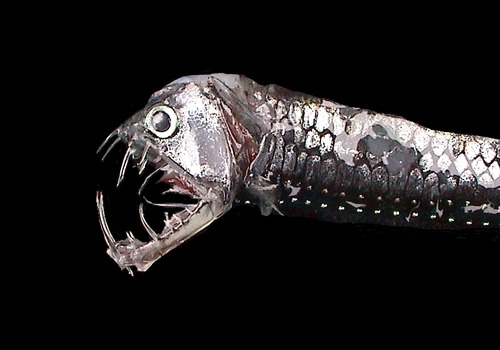
Are these fish the origin of the dinosaurs as they are very different than other fish?
We notice also that the dinosaur footprints found in many places are not deep don't match with their weight of dinosaurs walking on muddy ground, they should be much deeper. This could happen just if there was a different gravity.
There must have been another planet which was smaller and the gravity was lower so they could move easier.That planet was not like the moon and not like the earth but something in between in size.
Some say that Mammals lived at the same time, could be but not on the same planet.
Some of the world’s earliest mammals were the multituberculates, a group of small rodent like animals that first emerged on Earth about 165 million years ago. For the next 80 million years, they stayed small, seeming to evolve slowly. A new study indicates that at least one group of ancient mammals was already expanding 20 million years before the dinosaurs were wiped from the Earth. In such a case it could have been on the other planet. (No petrified mammals were found).
Some say that Mammals lived at the same time, could be but not on the same planet.
Some of the world’s earliest mammals were the multituberculates, a group of small rodent like animals that first emerged on Earth about 165 million years ago. For the next 80 million years, they stayed small, seeming to evolve slowly. A new study indicates that at least one group of ancient mammals was already expanding 20 million years before the dinosaurs were wiped from the Earth. In such a case it could have been on the other planet. (No petrified mammals were found).
Was there a different atmosphere?
There is a theory that says that the giant flying creatures of the dinosaur age could only fly if the atmospheric pressure was much higher than it is now: at least 3.7–5.0 so that they could fly.
read :
The present oceans are relatively young because they contain limestone not older than 200 million years. On the other hand, the continental landmasses are much older because, the oceans and the atmosphere shared the free CO2 equally. Consequently, the pressure of CO2 in the atmosphere was 8–10 bar in the age of the flying creatures . Where did the measured 55–70 bar of CO2 in limestone and other carbonates came from?. Today, vast deposits of sedimentary carbonate rocks are found on land and on ocean bottoms, >1,000,000 km3 throughout Earth’s crust. Above the continents, the CO2 was taken up by rainwater and by groundwater. This CO2-rich water reacted with rocks to form bicarbonates, followed by transport to the ocean and precipitation as calcium and magnesium carbonates. In the ocean, dissolved CO2 combined with the calcium hydroxide to form deposits of chalk, or it was taken up by coral, mollusks, and other living creatures to form giant reefs. A study of the distribution through time of these deposits gives us clues to the history of CO2 in the atmosphere the continents contain at least 2.82 × 106 km3 of limestone, which are the remains of deposits over the past 570 million years that have not been washed to sea or sub ducted back into Earth’s interior.
This is equivalent to a CO2 atmospheric pressure of 38 bar. If we add the carbonates found on the ocean floor, the equivalent CO2 atmospheric pressure rises to 55 bar. Integrating the values plotted in Figure 5 gives the progressive Depletion of CO2 from the atmosphere. Thus, CO2 is recycled: 55–70 bar or more is accounted for on the surface of Earth, and ~30 bar is in the process of being recycled in the planet’s interior. During the Carboniferous period, 350–280 Mya, these plants proliferated widely, covering the land surfaces with lush forests of giant ferns, trees, and plants of all types. Because the atmosphere was rich in CO2, but very poor in oxygen, dead plant material did not decompose rapidly, so layer upon layer of it was laid down in thick blankets that would transform over time to coal.
It is estimated that each 1-m thickness of coal comes from the compression of a 10–20-m layer of dead organic matter , so that today’s 10-m thick coal seam represents an original 100 m of decayed material. Such a thick layer of decaying matter is something that we do not see anywhere today. Tropical forests today only support a very thin layer of decaying matter because of rapid oxidation. Thus, 100-m- thick layers can only occur if the atmosphere discourages oxidation. This is additional strong evidence that the atmosphere in those distant times was rich in CO2, but poor in oxygen.
The concentration of oxygen slowly rose. These two changes, the decrease in CO2 and the rise in oxygen, thinned the forests and the dead material began to be oxidized more rapidly, so that dense layers of dead organics were no longer deposited. Evidence of this change in atmospheric conditions is that we cannot find any massive coal deposits younger than 65 million years.
Did high concentration of CO2 and the high pressure cause the purifying? The limestone caves were formed relatively recently indicates that the CO2 concentration in the atmosphere was very high long ago, leading to the deposits of limestone, but became very low recently, allowing limestone to dissolve.
Assume that Earth’s early atmosphere was very different, both in composition (mainly CO2) and total pressure. But that remains a theory, but indicates a period that the co2 level was very high.
How did the flying creatures from the age of dinosaurs have enough energy to fly when physiology, biology, and aeronautics say that this was impossible? Where did the equivalent of 50–70 bar of CO2 in limestone and other carbonates on Earth’s surface come from? Such a change couldn’t happen in a short time like 60 mil, years but much earlier. How could life have developed on Earth when astronomy says that Earth was too cold to sustain life?
There are many limestone caves throughout the world, some of which are several kilometers long. These caves are all relatively young, most of them <100 million years old, and were carved by running water, which dissolved the limestone.
The high concentration in the atmosphere, CO2 and the limestone could be an indication that it was another planet.
There is no logic explanation for such radical change on earth that the atmospheric pressure and the concentration of , CO2 could reach these levels and then go back to normal. Where did the measured 55–70 bar of CO2 in limestone and other carbonates came from?
High concentration of CO2 in some rocks indicates that there were two different planets with complete different kinds of limestone.
Birds and dinosaurs
This is equivalent to a CO2 atmospheric pressure of 38 bar. If we add the carbonates found on the ocean floor, the equivalent CO2 atmospheric pressure rises to 55 bar. Integrating the values plotted in Figure 5 gives the progressive Depletion of CO2 from the atmosphere. Thus, CO2 is recycled: 55–70 bar or more is accounted for on the surface of Earth, and ~30 bar is in the process of being recycled in the planet’s interior. During the Carboniferous period, 350–280 Mya, these plants proliferated widely, covering the land surfaces with lush forests of giant ferns, trees, and plants of all types. Because the atmosphere was rich in CO2, but very poor in oxygen, dead plant material did not decompose rapidly, so layer upon layer of it was laid down in thick blankets that would transform over time to coal.
It is estimated that each 1-m thickness of coal comes from the compression of a 10–20-m layer of dead organic matter , so that today’s 10-m thick coal seam represents an original 100 m of decayed material. Such a thick layer of decaying matter is something that we do not see anywhere today. Tropical forests today only support a very thin layer of decaying matter because of rapid oxidation. Thus, 100-m- thick layers can only occur if the atmosphere discourages oxidation. This is additional strong evidence that the atmosphere in those distant times was rich in CO2, but poor in oxygen.
The concentration of oxygen slowly rose. These two changes, the decrease in CO2 and the rise in oxygen, thinned the forests and the dead material began to be oxidized more rapidly, so that dense layers of dead organics were no longer deposited. Evidence of this change in atmospheric conditions is that we cannot find any massive coal deposits younger than 65 million years.
Did high concentration of CO2 and the high pressure cause the purifying? The limestone caves were formed relatively recently indicates that the CO2 concentration in the atmosphere was very high long ago, leading to the deposits of limestone, but became very low recently, allowing limestone to dissolve.
Assume that Earth’s early atmosphere was very different, both in composition (mainly CO2) and total pressure. But that remains a theory, but indicates a period that the co2 level was very high.
How did the flying creatures from the age of dinosaurs have enough energy to fly when physiology, biology, and aeronautics say that this was impossible? Where did the equivalent of 50–70 bar of CO2 in limestone and other carbonates on Earth’s surface come from? Such a change couldn’t happen in a short time like 60 mil, years but much earlier. How could life have developed on Earth when astronomy says that Earth was too cold to sustain life?
There are many limestone caves throughout the world, some of which are several kilometers long. These caves are all relatively young, most of them <100 million years old, and were carved by running water, which dissolved the limestone.
The high concentration in the atmosphere, CO2 and the limestone could be an indication that it was another planet.
There is no logic explanation for such radical change on earth that the atmospheric pressure and the concentration of , CO2 could reach these levels and then go back to normal. Where did the measured 55–70 bar of CO2 in limestone and other carbonates came from?
High concentration of CO2 in some rocks indicates that there were two different planets with complete different kinds of limestone.
Birds and dinosaurs
A greater problem would be for the flying dinosaurs.
Today, the world’s largest flying birds, the South American condor, the Australian kori bustard, and the largest European swan have wingspans no more than 4 m. Considering the limitation of skeletal and muscle structure, physiologists and aerodynamicists [5, 6] estimate that these birds which weigh up to 14.5 kg, represent the upper size limit of creatures that can support and propel themselves through air. How then could 86-100 kg creatures fly in the age of dinosaurs?
Predicting that some dinosaurs had air sacs and that was the reason to predict that they are the ancestors of birds, although it is thought that these dinosaurs were terrestrial and not avian dinosaurs
High concentration of CO2 that could be the reason that the dinosaurs had air sacs. Long before birds took flight, giant reptiles called pterosaurs dominated the skies.
High concentration of CO2 that could be the reason that the dinosaurs had air sacs. Long before birds took flight, giant reptiles called pterosaurs dominated the skies.
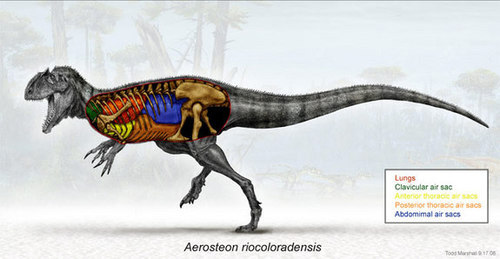
A new study concludes balloon-like air sacs extended from the pterosaurs’ lungs into much of the skeleton, reducing body density and providing an efficient breathing system by helping the exchange of oxygen and other gases in and out of the beasts’ bodies. The s strategy was similar to that used by birds that descended from dinosaurs much later.This flesh rendering of the predator Aerosteon as they might have been in life about 85 million years ago. This huge carnivorous dinosaur that lived about 85 million years ago had a breathing system much like that of today s birds, a new analysis of fossils reveals, reinforcing the evolutionary link between dinosaurs and modern birds. A new predatory dinosaur from Upper Cretaceous rocks in Argentina.
Birds with circulatory and respiratory systems capable of very high metabolic rates and oxygen supply permit the bird to fly.
In dinosaurs most probably to save air or oxygen to solve the problem of air low density or low concentration of oxygen on the planet more like a container or Compressors for Diving or have a constant supply of air, thus increasing the oxygen intake. and low air pressure like in the case of high attitude by birds another possibility is make them lighter or To lower their body density, making it easier to move or locomotory balance, and/or thermal regulation.
Birds with circulatory and respiratory systems capable of very high metabolic rates and oxygen supply permit the bird to fly.
In dinosaurs most probably to save air or oxygen to solve the problem of air low density or low concentration of oxygen on the planet more like a container or Compressors for Diving or have a constant supply of air, thus increasing the oxygen intake. and low air pressure like in the case of high attitude by birds another possibility is make them lighter or To lower their body density, making it easier to move or locomotory balance, and/or thermal regulation.
Another possibility was to help them to dive or to stay a long time under water as the stayed most of time in water or to float.
Evidence from the fossil record for the origin and evolution of this system is extremely limited, because lungs do not fossilize but skeletal bone and thus leave a record of their presence.
Evidence from the fossil record for the origin and evolution of this system is extremely limited, because lungs do not fossilize but skeletal bone and thus leave a record of their presence.
in China a dinosaur was found, it had 6-inch-long feathers down its back, or the Lythronax argestes found in Utah was probably covered in quills or feathers, but the purpose is unclear for sure it wasn't to protect its body like in the case of birds as it was a Triassic dinosaur and not avian.
A remarkable difference between birds and dinosaurs is that dinosaurs have teeth and birds haven’t. and if birds were so old like dinosaurs why don’t we find petrified birds and not only dinosaurs?
(but air sags in dinosaurs could have helped them to float as their weight didn’t help them to stay on ground a long time so they had to live in water the most of time.
(but air sags in dinosaurs could have helped them to float as their weight didn’t help them to stay on ground a long time so they had to live in water the most of time.
(its not enough to have wings or to lay eggs or even having air sags to consider them related )
In such a case we shouldn’t search for a link to the evolution theory as birds occurred after dinosaurs and they use them for flying but dinosaurs were on the ground, the similarity doesn’t mean there is a connection. Each creature developed itself on its own planet.
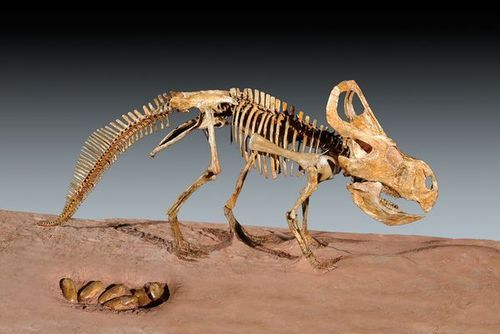
But this takes us back to the question : could dinosaurs according to the evolution theory really develop from the life form that existed before. We have a look how this life looked like:
(I just give you some examples of the different forms to try to find any logic similarity between the two forms).
The age immediately prior to the dinosaurs was called the Permian. Although there were amphibious reptiles, early versions of the dinosaurs, the dominant life form was the trilobite, visually somewhere between a wood louse and an armadillo.
In their heyday there were 15,000 kinds of trilobite. Around the time of the impact, they disappeared. Something similar happened to the dinosaurs 65m years ago. In the same way that the earlier impact seems to have cleared the way for them, the later crash made room for our ancestors, the mammals.
Cambrian period 542 ± 0.3 to 488.3 ± 1.7 million years ago
The Cambrian Period marks an important point in the history of life on Earth; it is the time when most of the major groups of animals first appear in the fossil record. This event is sometimes called the “Cambrian Explosion,” because of the relatively short time over which this diversity of forms appears. It was once thought that Cambrian rocks contained the first and oldest fossil animals, but these are now found in the earth found mostly in the north .
Newer form was the Opabinia related to today’s velvet worms. It possessed five huge eyes. Opabinia also has modern relatives called Onychophora, or velvet worms. They live on land, mostly in Australia; Sacabambaspis is an Ordovician arandaspid, a kind of primitive armored jawless fish that has been found in Bolivia in the Andes Mountains. It was about one foot long. Like all fish of its time, Sacabambaspis had no jaws. The only fin Sacabambaspis had on its body was the caudal fin, or tail Dinocaridida is the group which contains anomalacarids such as Opabinia and Anomalocaris
There has been much debate over what kind of animal members of Dinocaridida actually were. They possess jumbled-up features of two groups of modern animals, the arthropods and the onychophorans. They lived on every continent except Antarctica. They have gone extinct 65 million years ago.
A new species of Coelacanth was described around 1998 and it was named Latimeria menadoensis. It was found in Indonesia
The largest Latimeria chalumnae ever found was 6-½ feet long. This population of Coelacanths was also the shallowest-living ever found, with depths of 344 feet.
Coelacanths are one of the two groups of lobe-finned fish, or sarcopterygians, alive today. The other group is the famous lungfishes, which have the ability to breathe air and can live under dried-up lakes for years. Unlike lungfish, Coelacanths, or at least modern day Coelacanths, live in salt water.
There were a few prehistoric Coelacanths .
1 -The strange predator Anomalocaris stalked the seas in the Cambrian Period, 540 million years ago.
The age immediately prior to the dinosaurs was called the Permian. Although there were amphibious reptiles, early versions of the dinosaurs, the dominant life form was the trilobite, visually somewhere between a wood louse and an armadillo.
In their heyday there were 15,000 kinds of trilobite. Around the time of the impact, they disappeared. Something similar happened to the dinosaurs 65m years ago. In the same way that the earlier impact seems to have cleared the way for them, the later crash made room for our ancestors, the mammals.
Cambrian period 542 ± 0.3 to 488.3 ± 1.7 million years ago
The Cambrian Period marks an important point in the history of life on Earth; it is the time when most of the major groups of animals first appear in the fossil record. This event is sometimes called the “Cambrian Explosion,” because of the relatively short time over which this diversity of forms appears. It was once thought that Cambrian rocks contained the first and oldest fossil animals, but these are now found in the earth found mostly in the north .
Newer form was the Opabinia related to today’s velvet worms. It possessed five huge eyes. Opabinia also has modern relatives called Onychophora, or velvet worms. They live on land, mostly in Australia; Sacabambaspis is an Ordovician arandaspid, a kind of primitive armored jawless fish that has been found in Bolivia in the Andes Mountains. It was about one foot long. Like all fish of its time, Sacabambaspis had no jaws. The only fin Sacabambaspis had on its body was the caudal fin, or tail Dinocaridida is the group which contains anomalacarids such as Opabinia and Anomalocaris
There has been much debate over what kind of animal members of Dinocaridida actually were. They possess jumbled-up features of two groups of modern animals, the arthropods and the onychophorans. They lived on every continent except Antarctica. They have gone extinct 65 million years ago.
A new species of Coelacanth was described around 1998 and it was named Latimeria menadoensis. It was found in Indonesia
The largest Latimeria chalumnae ever found was 6-½ feet long. This population of Coelacanths was also the shallowest-living ever found, with depths of 344 feet.
Coelacanths are one of the two groups of lobe-finned fish, or sarcopterygians, alive today. The other group is the famous lungfishes, which have the ability to breathe air and can live under dried-up lakes for years. Unlike lungfish, Coelacanths, or at least modern day Coelacanths, live in salt water.
There were a few prehistoric Coelacanths .
1 -The strange predator Anomalocaris stalked the seas in the Cambrian Period, 540 million years ago.

Fossils of this creature were first discovered in the Burgess Shale, high in the Rocky Mountains of British Columbia, Canada. It is among the largest known animals of its time at 60 cm, though recent examples from China appear to be even larger. Its grasping limbs show that it was an active predator. Anomalocaris was widely distributed with finds in Australia, Canada, China, Greenland and Utah, USA.
2-Hurdia was a one and a half foot long creature .Hurdia is an anomalocaridid, and is usually considered to represent either a basal stem-lineage euarthropod, a member of the crown-group arthropods, or a sister group to the arthropods Hurdia was likely nektonic, since there are no trunk limbs for walking, and the numerous gills suggest an active swimming lifestyle.
2-Hurdia was a one and a half foot long creature .Hurdia is an anomalocaridid, and is usually considered to represent either a basal stem-lineage euarthropod, a member of the crown-group arthropods, or a sister group to the arthropods Hurdia was likely nektonic, since there are no trunk limbs for walking, and the numerous gills suggest an active swimming lifestyle.
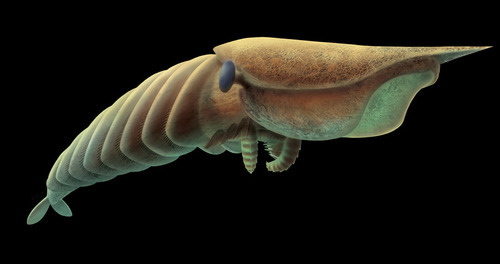
The animal propelled itself through the water column by waving its lateral lobes and gills. The large eyes, prominent appendages and spiny mouth parts suggest that Hurdia actively sought out moving prey items.
3. Scyphocrinites : Scyphocrinites was a strange Silurian-to-Devonian crinoid that floated upside down at the surface of the water .
3. Scyphocrinites : Scyphocrinites was a strange Silurian-to-Devonian crinoid that floated upside down at the surface of the water .
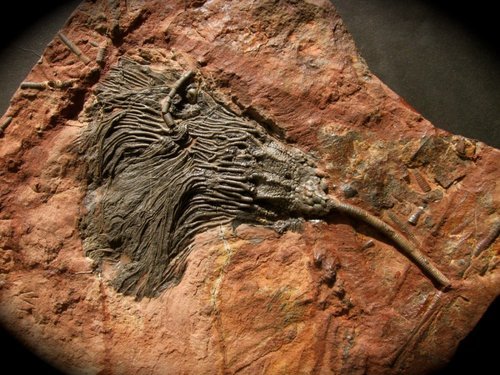
4 . Helicoprion:was a bizarre shark from the Carboniferous to the Triassic .
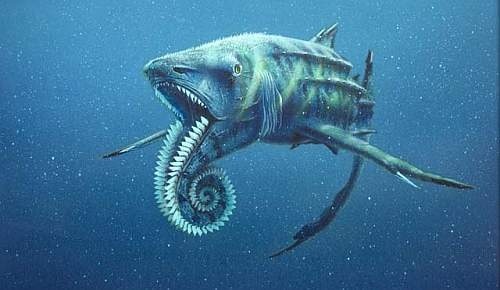
5. Opabinia. another small Cambrian critter, grew to eight centimeters (about three inches). This creature likely caught prey with the grasping claws of its long, tube-like proboscis and then stuffed the food into its mouth — much as an elephant uses its trunk. Opabinia may have even used its proboscis to pull worms out of their burrows.
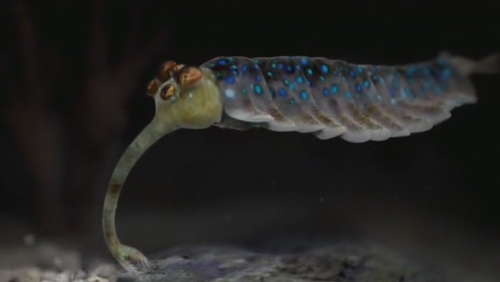
Groups of organisms, including some members of Foraminifera, Echinodermata, Mollusca, and the marine Diapsida all were devastated by the K-T event. On land
Most non- dinosaurian reptiles seemed to be Large relatively unaffected.
These were some of the living forms theoretically lived before dinosaurs, if we compare the two forms we find a great difficulty to find any evolutionary link between them either there is a part of the chain missing, (but a big part) or there isn’t any real connection between them as they lived on different planets, both kinds took a long time to evolve and dinosaurs probably much more than the 200 million years we assume they excited on earth (as they are much more complex) put probably the older remains disappeared for some reason. The different kinds of the dinosaurs mustn’t belong to the evolution theory or evolve a kind after the other but probably lived all at the same time and were petrified at the same time as a result of the impact event. This did not happen on the earth we know. In a million years we are not going to find petrified rabbits and petrified camels (which is impossible because the conditions will not be there). Are we going to say that camels evolved from cangurus and canguru evolved from rabbits as there is a kind of similarity? Or we can not say that bats are the origin of birds as both can fly.
Most non- dinosaurian reptiles seemed to be Large relatively unaffected.
These were some of the living forms theoretically lived before dinosaurs, if we compare the two forms we find a great difficulty to find any evolutionary link between them either there is a part of the chain missing, (but a big part) or there isn’t any real connection between them as they lived on different planets, both kinds took a long time to evolve and dinosaurs probably much more than the 200 million years we assume they excited on earth (as they are much more complex) put probably the older remains disappeared for some reason. The different kinds of the dinosaurs mustn’t belong to the evolution theory or evolve a kind after the other but probably lived all at the same time and were petrified at the same time as a result of the impact event. This did not happen on the earth we know. In a million years we are not going to find petrified rabbits and petrified camels (which is impossible because the conditions will not be there). Are we going to say that camels evolved from cangurus and canguru evolved from rabbits as there is a kind of similarity? Or we can not say that bats are the origin of birds as both can fly.
The great extinction and the petrification process
Why are the remains of the dinosaur era complete different than all other fossils. (They are petrified, I mean just turned to stone).
To make it more clear there are no petrified sloths also the lived 5 million years ago, like the fossils found in Peru but no petrified ones. There are also no petrified mammoth also both went instinct.
I think now we should not look to to this with the old fashion way, we should take advantage of the advance technology to see things we could not see what we were not able to see before. like for example electron scanning microscope. You can study the microstructure of bone tissue of the dinosaur, which is possible just in case of fast or instant preservation. We can’t see the petrified fossils in the same way like all other fossils. We used to see it from the outside and din’t now the they completely different from the inside. There is real life inside these specimen, life that is frozen in time.
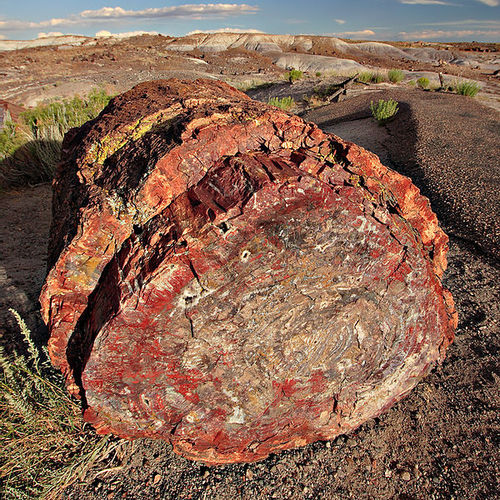
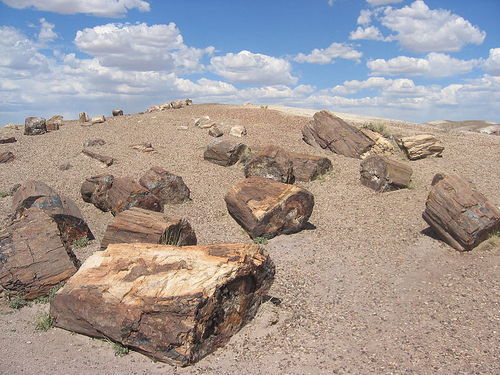
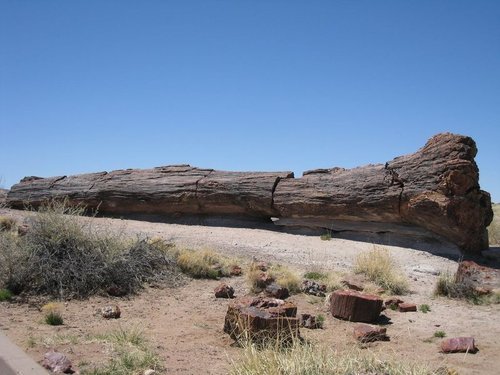
A theory say that fossilization does not take millions of years since under the right conditions a bone, an old boot, and even wood can become filled with minerals fairly quickly. Necessary ingredients for fossilization, even in a few thousand years are these; a quick burial under very deep water or volcanic ash. But as we see above are on higher ground which means there was no submersion. We notice too that the most of the petrified wood and dinosaurs are near the earth surface and not buried under sedimentary layers. That means that one of the most important guidelines in fossil dating (the Fossil sequences) is not present in this case. An example for this confusion is that they found 350 million years 20-foot tall petrified mushroom in Saudi Arabia seen below and as we know that Saudi Arabia has a lot of oil, geologically is the oil younger as that mushroom, but the oil is 4000 meters deep underground. How comes then that the older petrified mushroom lays on the top of the earth and the younger oil so deep? Then in this case there must be something wrong with sequence theory! Actually this would mean that the petrification and the extinction event was much younger than predicted, which means that there must be something wrong in the dating methods.
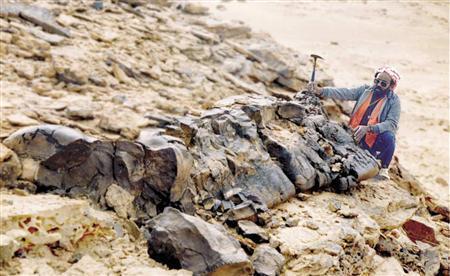
Read more at http://www.omg-facts.com/Science/350-Million-Years-Ago-There-Was-A-20-foo/50791#WepJIcsqwlFTivMU.99
It is thought that the petrifaction process occurs underground, when wood or bones becomes buried under sediments and is initially preserved due to a lack of oxygen which inhibits aerobic decomposition. Mineral-laden water flowing through the sediment deposits minerals in the plant’s cells. But this theory doesn’t seem to be the case in the world of dinosaurs. The petrified remains of trees or animals are different. They are very heavy (a high specific weight) high density and no sign of calcification or carbon content. The explanation is either that the condition on that planet caused such petrifying like the high concentration of CO2 in the air that preserved the specimen after dying, instead of rotten it just turned to stone. But it seems to have happened in a very short time almost instantly in the time where they still lived. We see petrified trees , trees turned to stone when they were still standing and living and then fall and broke (some are still standing) the content of the inside is different as you notice the different colors inside the tree. They call the process mineralization, meaning the the minerals inside came from the water it was flooded with. Actually the minerals were inside them in the fluid and blood. Below the Yellowstone National Park. This range contains well-preserved petrified trees that are still in their original upright position.

The next image is going to confuse you as the petrified trees lay broken on a hill and the sediments below are very young (as they are soft) that means that the petrification was much later. (Scientists should examine these sediments to determine its age). Its at the Petrified Forest National Park.
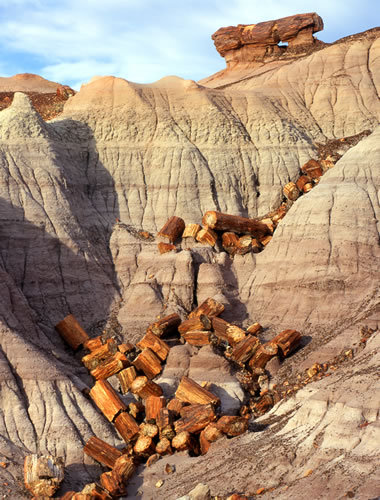
You notice the erosion below the tree on the top of the hill.

Above is the so called Polystrate tree fossil known as upright fossils they are trunks, or trees formed by rapid sedimentation. They are found in layers associated with an actively subsiding coastal plain or rift basin, or the accumulation of volcanic material.they are deeply rooted in place. This kind fits in the theory saying that petrified wood was formed in the same way, but there is a great difference as they are not the same when being microscope examined or cut and polished. They don't have the same formation like living tree like in the case of petrified wood and the substance is different.
There is also the so called Mummified wood and the submersed forests it’s the same techniques, but also not the same like the petrified once. We should not forget another kind, that the upright fossil trees found in Carboniferous coal-bearing strata. All these kinds according to the common theory should have been petrified, but they didn’t.
This process did not affect only trees but animals too, like the dinosaurs.
The sharpest look yet at the oldest known dinosaur embryos . Scientists uncovered clutches of fossilized eggs at the site in the Golden Gate Highlands national park, South Africa, many containing embryos. The process didn’t take long as the embryo didn’t rotten.
The nests belonged to Massospondylus, a six-meter (20ft) ancestor of long-necked “sauropod” dinosaurs that lived 190m years ago.
The nests belonged to Massospondylus, a six-meter (20ft) ancestor of long-necked “sauropod” dinosaurs that lived 190m years ago.
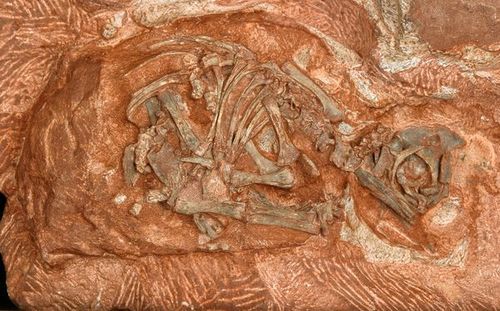
A nest full of fossilized dinosaur babies has been discovered in Mongolia. The approximately 75-million-year-old nest shows 15 juvenile members of Protoceratops andrewsi—a relative of Tricerato.
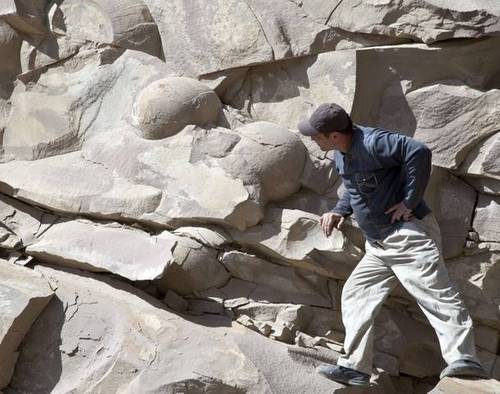
Fossilized dinosaur eggs have been found in Russia.

The photo below shows Dinosaur bone cells from the Morrison Formation in Utah that have been petrified with Notice that the different what was ones fluids inside turned instantly when it was still fresh and living to another matter like silica and quartz crystals (such form of matter exchange Couldn’t have happened by just have been submersed by water for a long period of time).
This must have happened as the fluid flow was active. Its the water that turned to silicon dioxide.
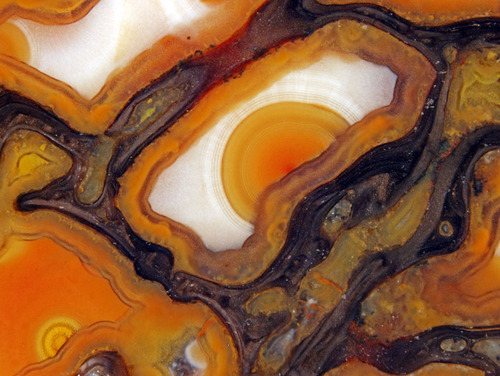
These contents would even disappear even within days after the death of the plant or animal. Compared with other common fossils you don’t find any trace of carbon or calcification, this indicates that it was a complete different process than what happens in the case of the other kind of fossils. It could be more logic that trees would convert to coal but not get petrified.
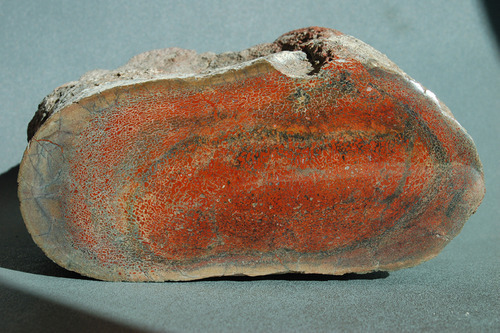
Above Close up of cell structure, the grayish pattern is bone marrow
and the red is filled in agate.

Close-up of petrified dinosaur bone Notice the amazing level of preservation displayed by the vascular system inside the bone.
Blood vessels and nerves in living organisms, appear here is filled with crystals in the photomicrograph of fossilized dinosaur bone shown above as seen below.
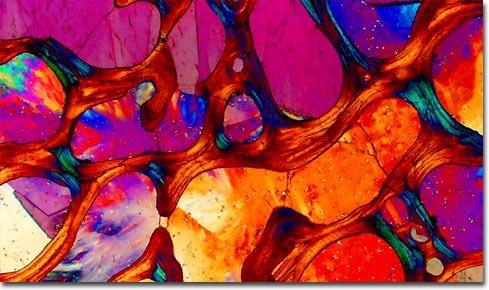
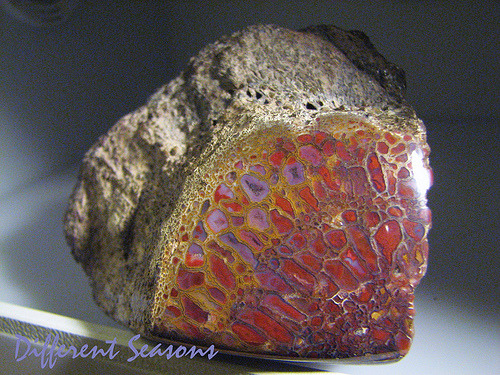
This photography above of a polished dinosaur bone is sold as a semi precious stone even on ebay you find a lot of them :
Some of them for less than 10 $. What astonished me is not the affordable price (which from the scientific point of view should be higher than diamonds). The noticeable thing is the detailed structure of the bone or three couldn’t be better seen by the most sophisticated microscopes as you can notice the fluids, fibers and marrow. Its exactly the same picture like in the living condition. Its live is captured in a stone form, you are almost wearing a living dinosaur. There should be more work done comparing such stones or it’’s cell structure with living forms. This could be a kind of finger print to classify the kind of species it represents and compare it with living once. Such fossils are complete different from the outside than from the inside. From the outside they are dead but not from the inside.

The photography above shows a portion of a petrified dinosaur bone that was sawn flat on both sides to highlight internal patterns. The original bone was replaced atom-by-atom with quartz agate.
Next you see Crystals within Haversian Canals. This can only happen when the creature was still living and the fluid flow inside the bones was active.
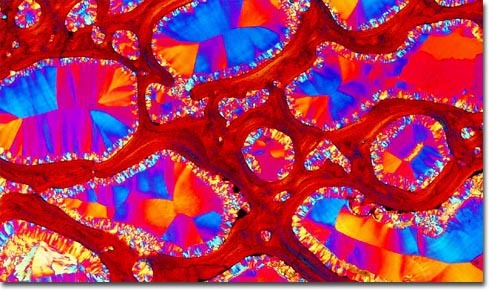
Next photomicrograph illustrates mineral formation in Haversian canals of a fossilized Hadrosaur bone recovered in Canada.
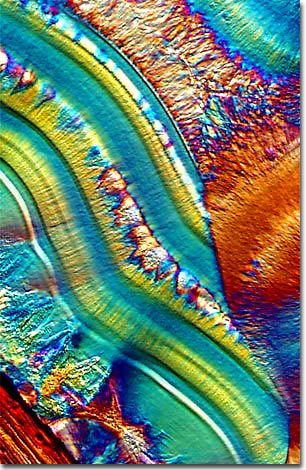
Next photographys of a petrified wood. You notice that the same process happened in the case of the petrified trees. These are species that experienced the same event that was followed by the mass extinction.
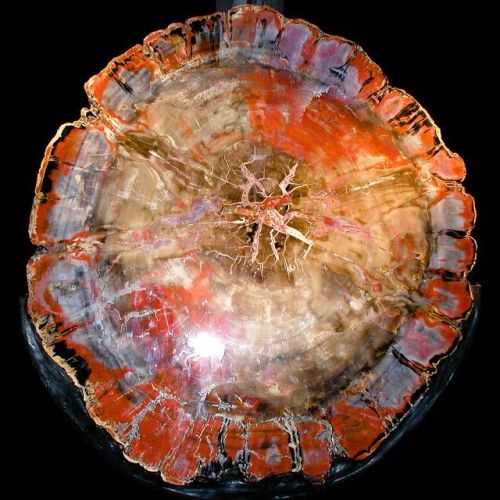

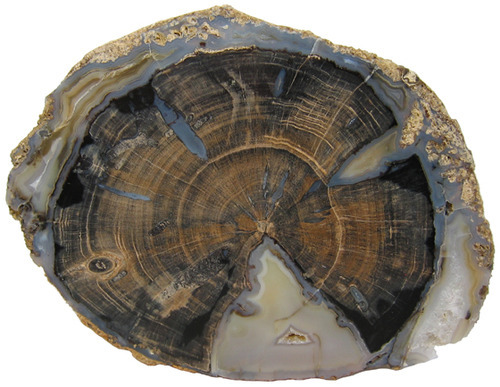

( Even the skin was petrified )
The remarkable preservation of macro and microscopic structures of petrified dinosaur bones and trees, has been the subject of many scientists : (what appears to be red blood cells have been described from Tyrannasaurus rex bones (Weiland 1997), while other dinosaur bones have been which “cannot be distinguished from modern bone ”(Weiland 1999) .Additionally, soft muscles, internal organs and even microscopic fibers have been well preserved in a juvenile dinosaur recovered in China)
On the next link you read too: (In contrast, the dinosaur specimen exhibits remarkable preservation of soft tissues to the ultrastructural level. The state of preservation in this T. rex bone resembles that of fixed tissues found in recent human bone, thus the preservation, or fossilization process must have immediately followed or have been concurrent with death. It must also have been rapid enough to foil decomposers, but the fine structure of the soft tissue does not exhibit the effects of any mineralization. Additionally, the fact that this level of preservation has remained to this day casts doubts on the time period that may have elapsed between fossilization and the present. The collagen fibers in the dinosaur bone appear to be mummified and not fossilized).
(Collagen fibers from a fresh human wound scab (Image 1) and similarly positioned T. rex bone collagen at the same magnification (Image 2) are remarkably similar.)
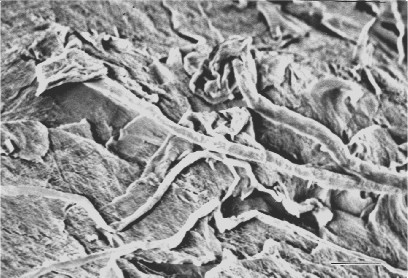
Image 1

Image 2
A 70-million-years-old Tyrannasaurus rex recently discovered in Montana, scientists reported, has apparently yielded the improbable: soft tissues, including blood vessels and possibly cells, that “retain some of their original flexibility, elasticity and resilience.”
Mary Higby Schweitzer 2004 gazed through a microscope in her laboratory at North Carolina State University and saw lifelike tissue that had no business inhabiting a fossilized dinosaur skeleton: fibrous matrix, stretchy like a wet scab on human skin, what appeared to be supple bone cells, their three-dimensional shapes intact, and translucent blood vessels that looked as if they could have come straight from an ostrich zoo.
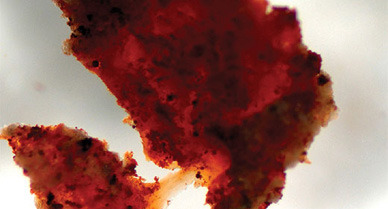
Above photography shows blood vessels and structures that looked like whole cells inside that T. Rex bone.

Tissue fragments from a Tyrannosaurus Rex femur are shown at left, when it is flexible and resilient and when stretched (arrow) returns to its original shape. The middle photo shows the bone after it is air dried. The photo at right shows regions of bone showing fibrous character, not normally seen in fossil bone.
I think this could happen in the case of bigger bones, as the instant petrification didn’t reach the inner part, but the outer part formed a coating and a vacuum isolation to the inner tissue and protected it so long.
watch interesting video
Furthermore, using a technique called mass spectrometry, the investigators found amino acid sequences of proteins in extracts of the dinosaur bone that matched sequences from proteins called actin, tubulin and histone4 that are present in the cells of all animals.
As of May 2013, in fossils from dinosaur-layer and deeper strata, researchers have discovered flexible and transparent blood vessels, red blood cells, many various proteins including collagen, actin, and hemoglobin, and powerful evidence for DNA.
Even collagen fibers have been discovered by scanning electron microscope in a petrified dinosaur bone.
The photomicrographs below are reflected light darkfield images of several thin sections made from a dinosaur (60x magnificatio)

A unique preservation of soft tissues in the ventrolateral region of the plant-eating dinosaur Psittacosaurus from the Jehol biota of China. The preservation is of a deep cross section through the dermis, which includes multiple layers of collagenous fibres.

A petrified frog where you see the skin and even the eyes

examining petrified wood by stereoscopic optical microscope , scanning electron microscope , computed tomography scanner shows biomolecules preserved in fossil conifer wood.
You find similarity to living trees, another indication of instant happening of the petrifying process while still living . staying a long time in water would destroy all these details.
there is a difference between mummified trees . Mummified trees are not the same as petrified wood .
The July 2004 issue of Sedimentary Geology included a paper by five Japanese scientists reporting their experiments on the rapid petrification of wood as an indication that silicified wood (fossilized by impregnation with silica) found in ancient strata must likewise have been rapidly petrified. After nothing that “several researchers believe that several millions of years are necessary for the complete formation of silicified wood ”, which seems to be a wrong theory.
The unsubstantiated dogma that says that petrification takes millions of years. Who proved it takes millions of years? There is no absolute proof that in the literature you will find that the scientific literature will say that such and such fossil was found in the so and so formation which is 100 million years old.
Careful analysis of different signals indicated that some samples of petrified wood in the authors’ possession, composed of silica of variable density, are the chemical negatives of the primordial living wood
I put a lot of links to show you how much research have been done and how much evidence proving that these species have been instantly petrified and how much the differ from other fossils.
An important question is why didn’t human remains which are 2 million years old didn’t get petrified and other kinds of mammals . Did they need more time? The answer is No, they just didn’t experience the same what the dinosaurs experienced. They didn’t experience the event that caused the petrification.
Another important example for the swift petrification is the so called dinosaur Coprolite or Dino Poop or dung. They must have been petrified when they were still soft. They wouldn’t resist the decay if being flooded for a long period. The outer details or texture would have been damaged or mixed with mud or sand.
Next you see some Coprolite images:

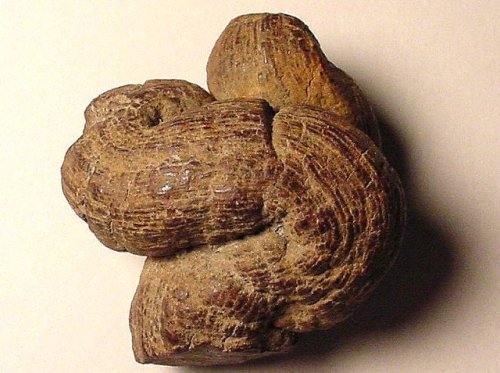
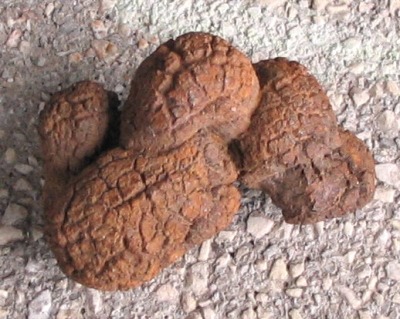
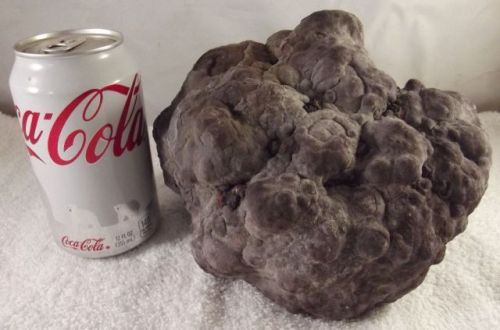
Next the nebraska Vertebrate Droppings. Here you see that a fast petrification process happened and then the flooding.

In the western desert in Egypt round stones some are smaller some are almost 1 m in diameter the call the place the valley of melons, it seems to be petrified fruit they are very heavy some are broken and you notice that the inside is hole and crystallized, an evidence that it happened in a very short time. And it was soft not hard containing fluid. Smaller once can be found in Sinai. Even well-preserved pieces of fossilized dinosaur dung - or “coprolites,”
Interestingly that the most of these petrified objects lay on the surface or near the surface (can not talk about Fossil sequences) even standing trees, this couldn’t have happened by being flooded for a long time or covered by mud or lay deep in the earth.
Interestingly that the most of these petrified objects lay on the surface or near the surface (can not talk about Fossil sequences) even standing trees, this couldn’t have happened by being flooded for a long time or covered by mud or lay deep in the earth.
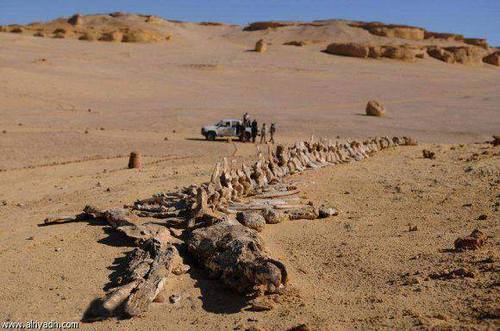
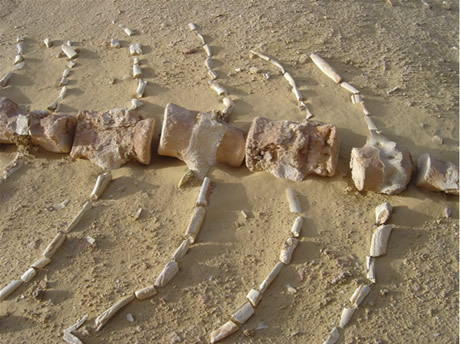
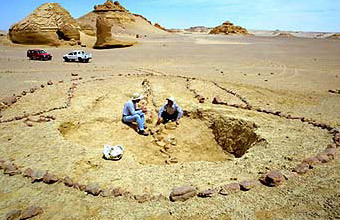
Above the valley of the whales Egypt. You notice how near to surface of the earth.
Not far from that place in Baharia petrified trees have been found. These trees just lay unburied on the top of the ground as seen next.

How could this petrifying happen? It happened suddenly and by an unusual force. It could have something to do with the impact itself which developed an unnatural energy that caused the transmission of matter like silica and other elements straight in to the bodies replacing the original matter with new ones, probably the high speed of the molecules’ or atoms caused by the impact like a kind of unusual atomic reaction, or the cause of some kind of Plasma.
Are the petrified remains of the dinosaur age really that old? Why are they in such a good condition? And that after such a long time 65 million years! No signs of weathering on them, mostly on the surface. Interestingly the ground beneath is a muddy ground remains of a rainy periods during the ice ages not extreme old , they should have been buried in clay, but they lay above. Could the scientists have been misled by the effect of the impact that made these objects look that old?
Are the petrified remains of the dinosaur age really that old? Why are they in such a good condition? And that after such a long time 65 million years! No signs of weathering on them, mostly on the surface. Interestingly the ground beneath is a muddy ground remains of a rainy periods during the ice ages not extreme old , they should have been buried in clay, but they lay above. Could the scientists have been misled by the effect of the impact that made these objects look that old?
Another question is: if the scientists relate the big variety of dinosaurs to the evolution theory why don’t we find these remains in layers the older deeper and the younger nearer to the surface? I therefore would say that these kinds lived together and ended together by being petrified at the same time due to the same cause.
The impact would cause a great heat wave which logically would burn and remains or bones to ashes , that means nothing left to be petrified but the wave that caused the petrifying was faster than the heat wave, or did it happen before entering the earth?
We have now a look in to the time before dinosaurs :
Scientists call the time before dinosaurs the Paleozoic and the time during the existence of dinosaurs the Mesozoic Era and the time after the Cenozoic Era .
1-The Paleozoic Era means “ancient life”
The Paleozoic is bracketed by two of the most important events in the Paleozoic took approximately 300 million years (542 mya to 251 mya .The history of animal life. At its beginning, multicelled animals underwent a dramatic "explosion" in diversity, and almost all living animal phyla appeared within a few millions of years. Many Paleozoic rocks are economically important. For example, much of the limestone quarried for building and industrial purposes, as well as the coal deposits of western Europe and the eastern United States, were formed during the Paleozoic.
2-The Mesozoic Era means “middle life”
1-The Paleozoic Era means “ancient life”
The Paleozoic is bracketed by two of the most important events in the Paleozoic took approximately 300 million years (542 mya to 251 mya .The history of animal life. At its beginning, multicelled animals underwent a dramatic "explosion" in diversity, and almost all living animal phyla appeared within a few millions of years. Many Paleozoic rocks are economically important. For example, much of the limestone quarried for building and industrial purposes, as well as the coal deposits of western Europe and the eastern United States, were formed during the Paleozoic.
2-The Mesozoic Era means “middle life”
The Mesozoic Era is divided into three time periods: the Triassic (251-199.6 million years ago), the Jurassic (199.6-145.5 million years ago), and the Cretaceous (145.5-65.5 million years ago).
* Mesozoic means “middle animals,” and is the time during which the world fauna changed drastically from that which had been seen in the Paleozoic. Dinosaurs, which are perhaps the most popular organisms of the Mesozoic, evolved in the Triassic, but were not very diverse until the Jurassic. Except for birds, dinosaurs became extinct at the end of the Cretaceous. Some of the last dinosaurs to have lived are found in the late Cretaceous deposits of Montana in the United States.
The Mesozoic was also a time of great change in the terrestrial vegetation. The early Mesozoic was dominated by ferns, cycads, ginkgophytes, bennettitaleans, and other unusual plants. Modern gymnosperms, such as conifers, first appeared in their current recognizable forms in the early Triassic. By the middle of the Cretaceous, the earliest angiosperms had appeared and began to diversify, largely taking over from the other plant groups.
* Mesozoic means “middle animals,” and is the time during which the world fauna changed drastically from that which had been seen in the Paleozoic. Dinosaurs, which are perhaps the most popular organisms of the Mesozoic, evolved in the Triassic, but were not very diverse until the Jurassic. Except for birds, dinosaurs became extinct at the end of the Cretaceous. Some of the last dinosaurs to have lived are found in the late Cretaceous deposits of Montana in the United States.
The Mesozoic was also a time of great change in the terrestrial vegetation. The early Mesozoic was dominated by ferns, cycads, ginkgophytes, bennettitaleans, and other unusual plants. Modern gymnosperms, such as conifers, first appeared in their current recognizable forms in the early Triassic. By the middle of the Cretaceous, the earliest angiosperms had appeared and began to diversify, largely taking over from the other plant groups.
3 - Cenozoic Era means means “new life”
Its name could have been called Age of Flowering Plants" or the “Age of Insects” or the “Age of Teleost Fish” or the “Age of Birds”, The Cenozoic is sometimes called the Age of Mammals, because the largest land animals have been mammals during that time.
Great change in the terrestrial vegetation and life forms could mean different planet
These names are then names of certain life forms.
Now according to my theory we are going to replace the word era or age with the word planet.
We can divide the “Age of Dinosaurs” and the “Age of Mammals” Replace the word “ age” with the word "Planet".
One of the planets had more water, limestone or sand stone the other granite and high humidity.
Now according to my theory we are going to replace the word era or age with the word planet.
We can divide the “Age of Dinosaurs” and the “Age of Mammals” Replace the word “ age” with the word "Planet".
One of the planets had more water, limestone or sand stone the other granite and high humidity.
Instead of planet 1 and planet 2 and planet 3
Planet 1 is the Paleozoic planet.
Planet 2 is the Mesozoic planet.
Planet 3 is the Cenozoic planet or planet earth as we know it, after the collision.
Planet 1 is the Paleozoic planet.
Planet 2 is the Mesozoic planet.
Planet 3 is the Cenozoic planet or planet earth as we know it, after the collision.
We can say that the Permian and the Jurassic are two live forms that existed on two different planets and not ages. Theoretically both experienced a mass extinction related to a meteorite impact, but I think it was one event that hit two different planets and caused them to collide.
Each planet had its geological nature what considers soil and rocks. The unfossilifererous schists , granite and basalt ( all considered volcanic rocks) that formed the core of large mountains are called Primitive rocks. Fossil-rich rocks of limestone and clay that were found on the flanks of mountains over the Primitive rocks . Finally , there were another group of fossiliferous rocks of limestone and sandstone laying over the Secondary rocks and forming the foothills of the mountains , this could be a sign of the colliding planets . Rocks with the same or similar species and fossils belong to the same planet and not just belonging to another age.
Most of the fossils the of “K-T extinction” (meaning the extinction of dinosaurs at the boundary between the Cretaceous period (K) and the Tertiary period (T) are in certain places or continents like America.
Determining the age of rocks or fossils that are millions of years old is not easy; carbon dating only has a reasonable resolution when used with organic material that is less than about 50,000 years old, so it is useless with the 65 million year old K-T material. Other methods of age determination are often less accurate or less useful in certain situations. So we don’t know exactly when the dinosaurs went extinct, and matching events precisely to give a picture of what was happening at a specific moment in the Mesozoic is not easy .
Dinosaur nests have been found well preserved with embryos in the eggs on the original spot on the granite mountains like in south Africa.
That is evidence that these creatures existed on the granite planet, or that the granite belongs to the planet where the dinosaurs lived.
Determining the age of rocks or fossils that are millions of years old is not easy; carbon dating only has a reasonable resolution when used with organic material that is less than about 50,000 years old, so it is useless with the 65 million year old K-T material. Other methods of age determination are often less accurate or less useful in certain situations. So we don’t know exactly when the dinosaurs went extinct, and matching events precisely to give a picture of what was happening at a specific moment in the Mesozoic is not easy .
Dinosaur nests have been found well preserved with embryos in the eggs on the original spot on the granite mountains like in south Africa.
That is evidence that these creatures existed on the granite planet, or that the granite belongs to the planet where the dinosaurs lived.
One of the twin planets was probably similar to mars or the moon (perhaps it was another moon) and they are not going to find Granite mountains on Mars although Mars is identical to the earth from the geological point of view and had volcanoes too which are high but not real mountains like on earth . probably no tectonic movements like assumed on earth . But are the granite mountains form by tectonic movements or do the heavy granite blocks cause tectonic movements and volcanoes as they slide deeper into the earth? Are they the cause of the so called ring of fire, as not far of it there is a ring of granite mountains.
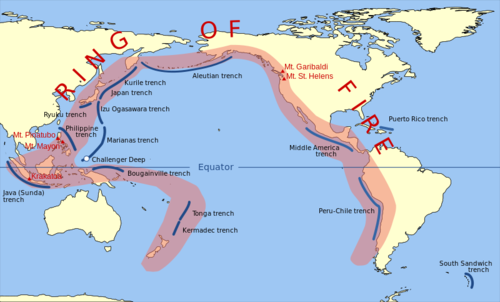
I think that the America got the most of the impact in the form of the ingenious rock mountains forming the Coast Mountains (The North American Cordillera), the best example is the The Sierra Nevada Batholith specifically the Yosemite area. According to my theory these mountains have been created by the impact and not the tectonic movement.
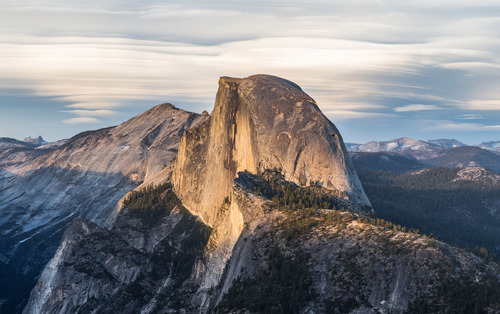
above the Half Dome, Yosemite, a classic granite dome of the Sierra Nevada Batholith.
The twin planet had a different fauna
In America you find the tallest trees in the world are the Redwoods, which grow in the coastal mountains from Big Sur north.The biggest trees however are the Giant Sequoia that live on the western slope of the Sierra Nevada. The oldest trees are the Great Basin Bristlecone Pines that are found in the high parts of eastern California. Large parts of the remains of the dinosaurs and trees are also found in America.
The giant sequoia the world’s most massive tree and arguably the largest living organism onEarth.
The giant sequoia the world’s most massive tree and arguably the largest living organism onEarth.

They are the tallest ,the widest and the longest-lived extant species of tree.
Are the huge old tree in America a sign that some species from the dinosaur planet could have survived the impact as they have been buried in the ground
Is that a sign that the dinosaurs could have had an extreme long life too which explains getting that huge?
Crocodiles are creatures that could be related to the dinosaurs. Did they survive the impact because they were in the water?
Crocodile skin is thick specially the top of the body a kind of protective shield . Is it to protect these creatures from different climate? Perhaps higher radiation or high UV radiation or strong sand storms. As the upper part that was exposed to these circumstances is protected.
Petroleum is also a questionable issue. Did the oil belong to that planet which had another nature, another atmosphere and another air? Due to the high content of CO2 and perhaps methane and ethane gases. Were there perhaps lakes of oil, which have been buried? These large amounts on earth are questionable too and also the unexplainable nature of oil.
You shouldn’t look at me as if I were crazy, if we don’t know enough doesn’t mean we know everything.
There is always something new discovered that could change the belief in some theories, like a discovery made by NASA on Saturn’s largest moon Titan which proves that oil could be created in a natural way and not like in our mainstream imaginary way.
NASA’s Cassini space probe discovered that Titan Saturn’s largest moon clouds, lakes and rains are made up of hydrocarbons, such as ethane and methane rather than water.
Did these gases turn to oil as a result to the impact and being under the pressure of millions of tons of ruble, that could be the explanation finding oil inside the sedimentary rocks, as it was in the gas state it could get into the rock. I think that is much more convincing theory than the one saying that living creatures have been buried and being cooked.
But there is a question why are the oil fields so deep 5000 meters and the remains of dinosaurs near the surface of Earth ? Are the buried under the rubble of the planet that hit the Earth ? That means that oil don’t belong to the same planet of the dinosaurs . Another question is why when drilling for oil you find sedimentary rocks and not Granite ? You find granite on the top but the original earth crust is of sedimentary origin and not granite.That could mean that Granite didn’t come from bottom to the top but conversely .
Dinosaur Fossils Are Sometimes Discovered Near Oil Deposits
(Some have questions to ask. Like when did this twin planet form and how did life forms on it and Earth turn out to be similar? One earth existing is remarkable enough, but two Earths in which animals evolved in nearly the same ways is completely improbable.)

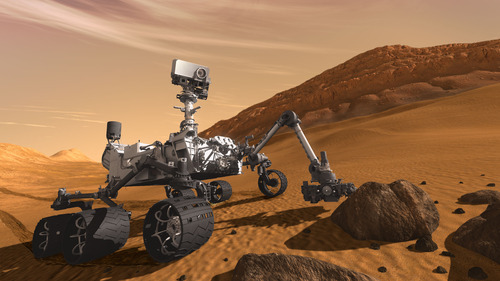
(above you see the similarity between earth and mars the hard dark rocks are probably remains of a destroyed planet or meteorites that fall on the planet, they are scattered everywhere). As you notice that the high mountains are volcanoes, but no granite mountains no tectonic plates.
We shouldn’t forget that in our solar system there are similar planets like Mars and some are complete different they even are trying to find proves that life existed once on Mars. They are even trying to find life on other solar systems, why shouldn’t it be more reasonable to have life on a planet near the earth?
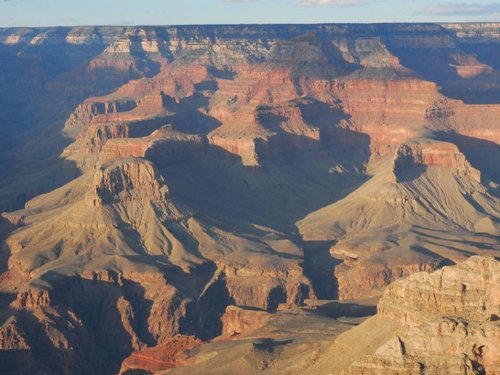
Above is it the Grand Canyon or Mount Sharp. Before curiosity landed on mars, the layers of sediment and rock on the red planet were compared to the Grand Canyon, shown here. Scientists now find that the color and thickness of exposed rock are very similar.
Below is an image of Mars for comparison.

Now the question is which one was the original planet earth ? We have to think out of the box sometimes to get answers.
By Farid Roushdy
Email : farid.roushdy@yahoo.com